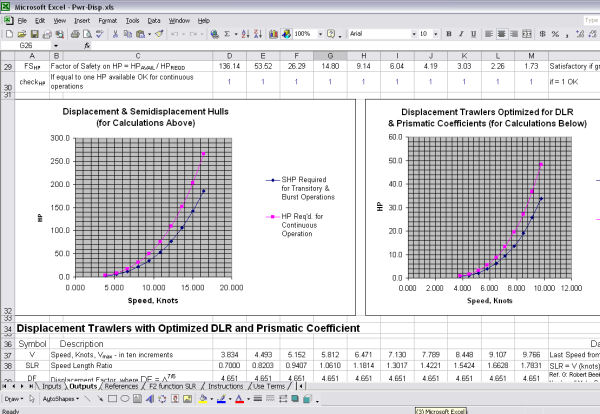Displacement &Semi-Displacement (or Semi-Planing)
Boat Calculations (English Units)
|
Description: This popular boilerplate template performs powering calculations (power prediction methods) applicable to two modes of boat or ship operation. The first is the displacement mode and the second involves semidisplacement or semiplaning mode of operation. Result graphs are automatically generated and show speed in knots versus the brake horsepower required. Because the input weight is important, this spreadsheet is setup to conveniently calculate the vessel's weight in various operational conditions. This template also checks to see if the vessel will go it's intended range, if the installed horsepower is adequate and if the stern's quarter butt exit angle permits the input speed. These calculations apply generally to calm water performance. The first set of calculations are for most types displacement and semi-displacement, or semi-planing vessels. They are based on procedures described by Dave Gerr in Reference D. The second set of calculations applies only to displacement vessels (that are optimized for displacement length ratio and prismatic coefficient) and are adapted from methods presented by Robert Beebe in Reference K. References D and K are recommended reading for understanding the processes automated in this spreadsheet. The other references contain supplemental information, but they are not needed for implementation of these calculations. This template is designed for use with English units. The first set of output computations apply to displacement and semi-displacement vessels. Semi-displacement, or semi-planing, boats normally operate at speed length ratios, V / LWL1/2, from about 1.3 to 1.4 all the way up to about three. However, in order to reach speeds in excess of maximum displacement speed, a vessel must have the appropriate aft quarter butt exit angle. An example drawing of this exit angle is provided in the spreadsheet along within the output calculations. If the aft quarter butt exit angle is too large, these calculations are automatically modified to only go up to the maximum speed that is allowable for the exit angle that is present. However, the automated result will never be less than the maximum allowable displacement speed. Since all this automated, a complete understanding is not crucial. What must be understood is decreasing the hull exit angle will often let the spreadsheet evaluate higher speeds. The second set output of calculations apply only to displacement mode. Displacement ships can only go up to their maximum displacement speed which is calculated in this spreadsheet. This maximum displacement speed is a function of both the weight and the length of the boat. The maximum speed length ratio normally associated with displacement mode is usually between 1.3 and 1.4. But light and long vessels can exceed this displacement limit and these effects are taken into consideration by this spreadsheet. This second set of calculations assume that the boat has been designed with an optimum prismatic coefficient, that corresponds to it's displacement length ratio. Beebe discusses these optimization techniques in References G and K. Other references also discuss the technique.
There are several advantages and benefits
associated with these calculative methods. First this approach saves
time. Numerous computations are automatically and quickly done on
your input data. This approach is also cost effective because the
calculations are already setup for you. As a result your research
time is minimized to familiarization of concepts when necessary and not in
time consuming procedural development activities. Electronic
Document Type: Microsoft Excel
spreadsheet Cost:
$35 US funds Number of
Pages: Inputs Sheet, Outputs Sheet,
References, Figure and Notes Sheet, F2 Function SLR Page, Use Terms Page and Instructions
Page.
Outputs:
Recommended Reading:
Terms: Prior to purchase, read our End User License Terms.
Download Now: click the following hyperlink to pay $35 fee and then immediately download the zip file containing the template. Minimum System Requirements: Windows 95/98/NT/2000/XP/Vista/Windows7 Sample: A sample of an output page is shown below.
|



